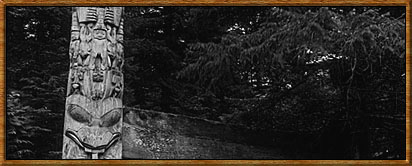 
|
Hiellan

This frontal pole in a very archaic style was created before 1840. It stood
before House for a Large Crowd of People, which belonged to the town chief.
Albert Edward Edenshaw lived there when he was young and inherited it later.
Photograph by Harlan I. Smith, 1919.
CMC 46,694.
Hiellan was a town of some importance in the early nineteenth century, and an impressive fort stood on the opposite side of the mouth of the Hiellan River on Graham Island. Both Haida and Tsimshian myths include accounts of its tricky defences and the battles fought there. Hiellan belonged to two branches of Eagles. The leading Eagle chief, Sqilao, was closely related to the first known Chief Edenshaw who was the uncle of Albert Edward Edenshaw and for whom the triple mortuary at Kiusta was erected.
The only surviving house frontal pole at Hiellan was photographed by Harlan I. Smith of the Canadian Museum of Civilization in 1919. It had stood there for over a century before it was transported in 1947 to Prince Rupert, where it was placed by the road into town to welcome visitors. After a short sojourn in Victoria at the Royal British Columbia Museum, the pole was returned to Masset. The shed in which the pole was stored collapsed under the snow load in the winter of 1993, and it was moved into Haida artist Jim Hart's carving shed, where it awaits replication.
This pole and the triple mortuary at Kiusta were both carved around 1820 by Sqiltcange, who came from Tsal village. Both monuments emphasize large Bear figures with a myriad of small figures emerging from their joints and orifices. The poles are unique in providing examples of the archaic style of Haida art similar to that seen by the first Europeans to visit Haida Gwaii.
|